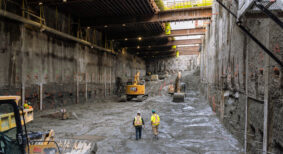Should you buy, rent or lease equipment for your construction projects? Given that equipment investment is a necessary cost, it’s a question that many general contractors and construction companies grapple with regularly. But the answer isn’t always straightforward; each business and financial situation is unique and the decision should be made on a case-by-case basis. There are several factors to consider, including the overall cost, the amount of operating funds available, number and length of projects, the usable life of the equipment, as well as your tax situation.
The option you choose will impact your cash flow, so how do you know which one will best help manage this, and what are the benefits or drawbacks of each? A cost benefit analysis will be necessary to understand how the repayment terms of each will affect your cash flow, as well as how it meets your business’ growth goals.
BUYING
Heavy equipment such as bulldozers, cranes, excavators and forklifts come with hefty price tags, and general contractors or construction companies don’t always have enough capital to make these purchases outright. Some may use their credit line, but it’s important that the loan term matches (or is close to) how long the asset will be held, in order to avoid short-term pressure on cash flow. Benefits of ownership include unrestricted availability of the equipment, cheaper long-term costs, deductions for depreciation and interest and a return on your investment when you sell. But there are other costs of ownership that need to be factored in such as regular maintenance, storage, transportation, and insurance, though these can be offset by renting out the equipment when it’s not in use.
Pros: Lower long term cost, accrued equity.
Cons: High upfront costs deplete cash on hand.
FINANCING
Financing can be obtained through a commercial loan or sometimes, directly from the distributor that is selling the equipment. In either case, you’ll need to determine whether the financing plan and the terms offered are competitive compared to other sources. Understand how the agreement is structured; often the equipment itself is used as collateral but the lender may otherwise require a personal guarantee or impose a blanket lien.
Pros: Fixed term amount helps keep cash flow steady; you own the equipment once the loan is paid.
Cons: Higher interest rates; requires strong credit score.
LEASING
Generally, leasing provides more options, including the choice of new or used equipment, flexibility on the length of the lease, and the opportunity to buy the equipment at the end of the term. Depending on the contract, you’ll either have a ‘true’ lease, or a lease that is essentially another form of financing. (A dead giveaway is whether the buy out is far less than market value). This matters from an accounting perspective, because the latter will be treated as a purchase loan and show up on your balance sheet, which will present timing issues between your cash flow out and tax deductions. With a true lease, the leasing company (usually) owns the equipment during the term so it is not reflected as an asset on your balance sheets, but rather becomes a monthly expense, which can be written off on taxes. But consider what conditions they place on the equipment and whether that may have an effect on your business. While monthly lease payments are usually lower than financing, it can be more expensive in the long run as costs add up.
Pros: No down payments necessary, greater flexibility.
Cons: Usually higher long-term costs, difficult to break the lease unless you purchase the equipment.
RENTING
This option provides a lot of flexibility in terms of choice, commitment and responsibility, but those benefits come at a price. Contractors will find renting ideal if work projects are sporadic, if they only need equipment for a particular short-term job or they want to try the newest and latest equipment on a trial basis before committing to a purchase. There is no upfront capital required, and you don’t have to carry any maintenance costs, but consider that the rental payments are steeply marked up since they often include the cost of ownership and depreciation, so this is an expensive option over the long term. If you’ll use a piece of equipment for several jobs, many times the rental cost may equal the purchase price so it may be wiser to purchase instead.
Pros: Payments are tax-deductible; operating capital remains intact.
Cons: Higher monthly cost, no equity accrued.
As you can see, the decision to buy or lease equipment requires careful consideration. When it comes to financing, depending on the size of the loan versus the capital that you are putting in, you may have little or no negotiating power with a lender or leasing company. It’s important to get various quotes, understand why one may be cheaper than the other, and ensure equal comparisons so you can best manage your cash flow while also achieving your long-term goals.
Additionally, there are various tax deductions to consider depending on the financing option you choose, and how it is structured. Speak to your accountant or tax professional to determine which financing method is best for your circumstances and to help ensure you follow the necessary accounting and tax rules.
Mahyar K. Hansotia is president of Sobel and Company, Professional Corporation, focused on business owners of small- to mid-sized companies, as well as large corporations, who are looking for financial acumen and strategic business expertise over and above traditional chartered professional accountant services. Contact him at Mahyar@sobelandco.com.









